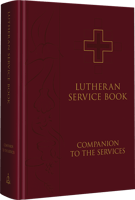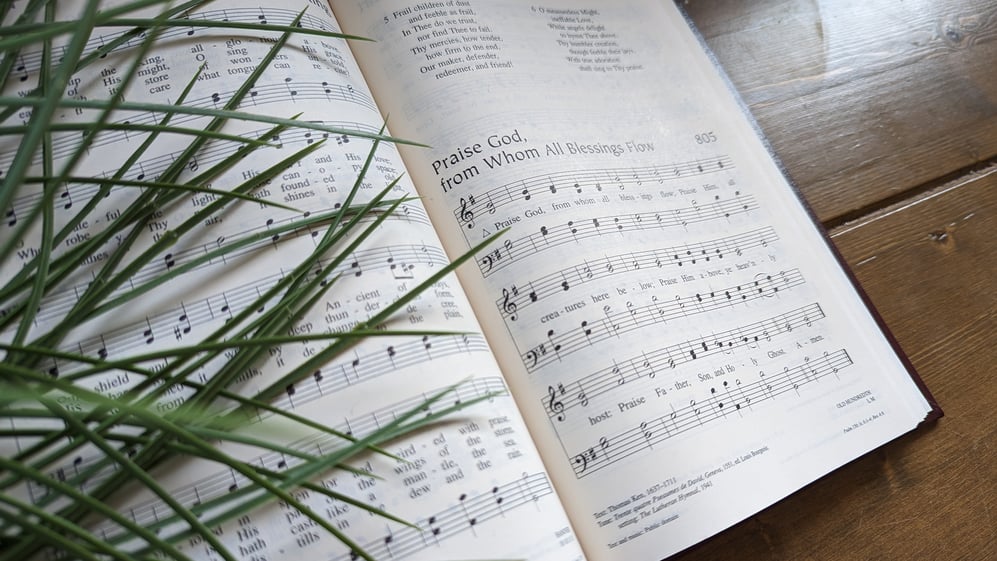When you hear the word doxology, what comes to your mind? For many, it’s a familiar tune and the words:
Praise God, from whom all blessings flow;
Praise Him, all creatures here below;
Praise Him above, ye heav’nly host:
Praise Father, Son, and Holy Ghost. Amen. (LSB 805)
This hymn, popularly known as the “common doxology,” is the final stanza of Thomas Ken’s morning and evening hymns (LSB 868 and 883), which were written for the students at Winchester College.
What is Doxology?
As with all doxologies, “Praise God, from Whom All Blessings Flow” praises the triune God: Father, Son, and Holy Spirit. When praying the Psalms, it is customary to append a doxology as a confession that the God we worship is the triune God. As a stand-alone hymn, however, the “common doxology” draws from the doxologies found in Scripture (for example, Romans 11:36; Galatians 1:5; Ephesians 3:21) as well as from the liturgical tradition of the Church (as in the Gloria Patri). Consisting of four lines, this simple doxology begins by reflecting on the blessings that come from God (Genesis 1:28; 2:3; Ephesians 1:3). The second line confesses that our worship is that of all creation (Psalm 69:34; Romans 8:19; Colossians 1:23; Revelation 5:13). This earthly worship is joined with the worship of the heavenly host (Isaiah 6:3; Luke 2:14) in the third line. All of this, as the fourth line confesses, is the worship of the one true God: Father, Son, and Holy Spirit.
The Companion to the Services defines doxology as this: “Greek: δοξολογία, ‘word of praise.’ Generally, any expression of praise to God, especially a trinitarian formulation. Specifically, the Gloria Patri (‘Glory be to the Father and to the Son . . .’), used to conclude psalms and canticles. By extension, a concluding ‘doxological’ stanza in hymns that acts as a metered Gloria Patri” (p. xxxv–xxxvi).
Historical Development
In the Hymns
A doxology in praise of the Father through the Son and through the Holy Spirit is known from the end of Clement of Alexandria’s sermon on “The Rich Man’s Salvation” (“Quis dives salvetur”), which dates from the end of the second century. By the fourth century, Arian teachings, which denied that Christ was coequal with the Father, led orthodox Christians to sing praise to “the Father and the Son and the Holy Spirit.” The addition “as it was in the beginning, is now, and will be forever” was known by the early sixth century. Concluding doxological stanzas were added to both old and new hymns beginning around the eleventh century. These stanzas tended to wander from hymn to hymn, so that different manuscripts attached different doxologies to a single hymn. It was also not uncommon for doxological stanzas to vary by liturgical season. It is therefore meaningless to try to determine which doxology was original to a particular hymn and an exercise in frustration to attempt to assign a date of composition to doxological stanzas attached to hymns written before about the twelfth century. In the same way, it is sometimes difficult to determine where an English translation of a doxological stanza first appeared, because such stanzas tended to float from one book to another.
In the Services
The Gloria in Excelsis in the Divine Service is sometimes called the Greater Gloria or Greater Doxology. This entire hymn is summed up with a grand trinitarian doxology as the Holy Spirit, mentioned for the first time, is united with Christ in the Father’s glory. This reference to the Trinity, however, does not detract from the fact that the Gloria in Excelsis is foremost a Christological hymn as it takes up some of the Church’s most ancient language by which the Son of God was both proclaimed and acclaimed.
The appearance of the Lord’s Prayer in the Didache also serves as the earliest attestation of the doxology (“For Thine is the kingdom . . .”), which does not appear in the best manuscripts of the New Testament. Biblically, the nearest parallel to the doxology is found in the Old Testament.
Yours, O LORD, is the greatness and the power and the glory and the victory and the majesty, for all that is in the heavens and in the earth is Yours. Yours is the kingdom, O LORD, and You are exalted as head above all. (1 Chronicles 29:11)
In the Didache, the doxology is slightly truncated from the final form—“For to you is the power and the glory forever”—and also appears as the conclusion to two other prayers in the short section on the Eucharist. While the doxology appeared in some of the Eastern rites, it did not find a place in the Roman rite. This omission continued even at the time of the Reformation. Luther, for example, makes no reference to it in his Deutsche Messe, nor did he include it in the Small Catechism, even though it does appear in his Bible translation of Matthew 6. Nevertheless, some of the church orders did include the doxology, and this became yet another example of the varying practices that came to characterize the Lutheran rites.
Incorporating the Doxology into Worship
Standing for Doxological Stanzas
LSB features a triangle to mark concluding doxological stanzas, that is, final stanzas offering praise to the Father, Son, and Holy Spirit. Worship Supplement (1969) used stick figures of a standing person to indicate that the congregation should stand. The origin of standing for doxological stanzas is obscure, but some older pastors recall that it was done at Concordia Seminary in St. Louis in the 1950s, and it may have started there around that time. Outside the Missouri Synod and churches previously affiliated with it (such as congregations that once belonged to the Missouri Synod but are now part of the Evangelical Lutheran Church in America), the practice appears to be unknown.
Even within Missouri, the practice has not been consistent. For example, in some churches the people stand for all doxological stanzas, in others they do not stand if the hymn is sung during Communion, and in others they do not stand at all. In still others the people stand for all stanzas of every hymn or of certain hymns (such as the entrance hymn). In codifying such a recently introduced and inconsistent practice, the editors of LSB used the definition of Doxology in the hymnal’s Glossary (p. xxiv): “Words of praise addressed to the triune God. Hymns that conclude with a doxological stanza are so indicated with a [triangle].” This definition excludes stanzas that are simply about the Trinity and not addressed to the triune God (“The Gifts Christ Freely Gives,” LSB 602, and “The Church’s One Foundation,” LSB 644, for example). It also excludes stanzas that are more supplication than praise (“Alleluia, Song of Gladness,” LSB 417). Hymns where the doxological stanza does not conclude the hymn also do not have that stanza marked (“We Praise You and Acknowledge You, O God,” LSB 941, stanza 2).
Because the practice of standing for doxological stanzas is relatively recent, without a long tradition behind it, the triangles in LSB are not intended as prescriptive but as a guide for congregations that choose to adopt the practice.
What Does Doxology Mean to Me?
The purpose of every creature—both animate and inanimate—is doxology (see Psalm 148). This purpose, written on the heart of every creature (cf. Romans 2:15), may be called the “doxological imperative.” Perhaps one may ask, “Why do we sing at all? Isn’t it possible to offer doxology through speech alone?” Through baptismal participation in Jesus’ blood, the Church stands both at the cross and at the empty tomb of the resurrection. Equipped with the Gospel promises of God, our doxological worship confesses, “I will sing of the steadfast love of the LORD, forever” (Psalm 89:1). It was in this vein that Luther could exclaim in the preface to the 1524 collection of hymn motets that “we should know nothing to sing or say, save Jesus Christ our Savior.”
Portions excerpted from Lutheran Service Book copyright © 2006 Concordia Publishing House. All rights reserved.
Portions excerpted from Lutheran Service Book: Companion to the Hymns copyright © 2019 Concordia Publishing House. All right reserved.
Portions excerpted from Lutheran Service Book: Companion to the Services copyright © 2022 Concordia Publishing House. All rights reserved.

Learn more about the Doxology in worship by ordering Lutheran Service Book: Companion to the Services today.














.jpg?width=50&height=50&name=IMG_20220621_160541_456%20(1).jpg)
